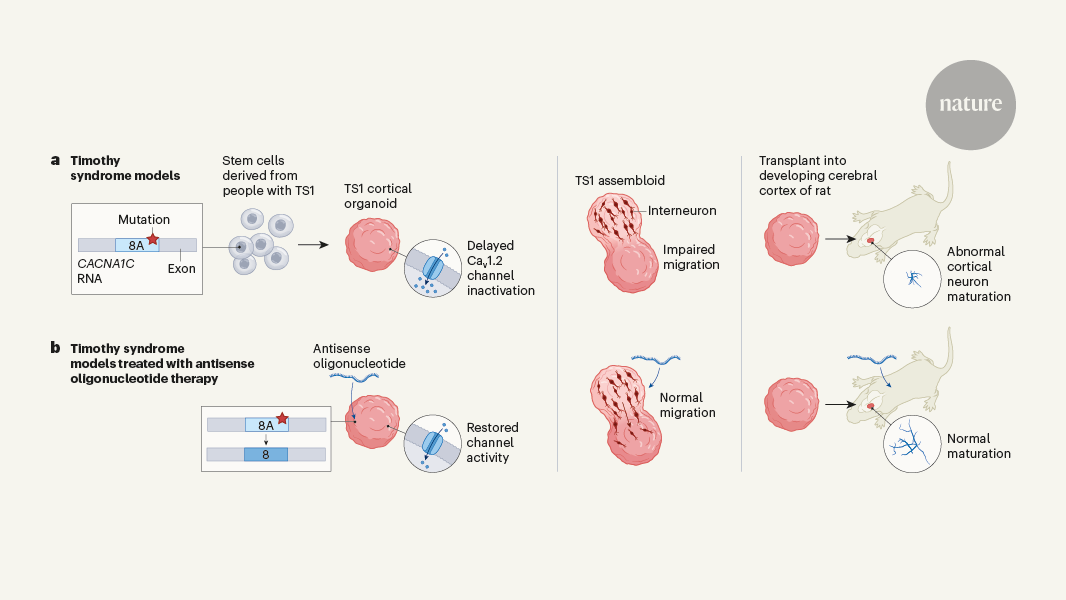Using Patient-Derived Brain Organoids to Identify Potential Treatments for the Genetic Disorder Timothy Syndrome
Core Concepts
Patient-derived brain organoids can be used to identify potential therapeutic strategies for severe neurological conditions like Timothy syndrome that lack effective treatments.
Abstract
The article discusses the use of brain organoids, which are complex 3D neural tissues generated from patient-derived induced pluripotent stem cells, as a model system to understand disease mechanisms and test potential therapies for neurological conditions.
The authors focus on Timothy syndrome, a severe developmental disorder with limited treatment options. By generating brain organoids from patients with Timothy syndrome, the researchers were able to gain insights into the underlying disease mechanisms. They found that the genetic mutation responsible for Timothy syndrome leads to the aberrant splicing of an ion channel gene, resulting in disrupted neuronal function.
Importantly, the researchers were able to use the brain organoid model to identify a potential therapeutic strategy - targeting the aberrant RNA splicing with antisense oligonucleotides. This approach was able to rescue the neuronal defects observed in the Timothy syndrome brain organoids, suggesting it could be a promising avenue for developing treatments for this condition.
The use of patient-derived brain organoids represents a powerful tool for understanding complex neurological disorders and accelerating the development of effective therapies. This study demonstrates the value of this approach in identifying targeted RNA-based interventions for genetic disorders that lack adequate treatment options.
Targeting RNA opens therapeutic avenues for Timothy syndrome
Stats
Timothy syndrome is a severe developmental disorder with limited treatment options.
The genetic mutation responsible for Timothy syndrome leads to aberrant splicing of an ion channel gene, disrupting neuronal function.
Targeting the aberrant RNA splicing with antisense oligonucleotides was able to rescue the neuronal defects observed in Timothy syndrome brain organoids.
Quotes
"Using stem cells, it is now possible to generate complex 3D neural tissues. These structures, known as brain organoids, can be made from a type of cell called induced pluripotent stem cells, which are reprogrammed from an individual's blood or skin cells and have the potential to become any cell type in the body."
"The authors focus on Timothy syndrome, a severe developmental disorder with limited treatment options. By generating brain organoids from patients with Timothy syndrome, the researchers were able to gain insights into the underlying disease mechanisms."
Key Insights Distilled From
by Silvia Velas... at www.nature.com 04-24-2024
https://www.nature.com/articles/d41586-024-00911-1
Deeper Inquiries
How can the insights gained from the Timothy syndrome brain organoid model be leveraged to develop treatments for other neurological disorders?
The insights gained from studying Timothy syndrome brain organoids can be instrumental in developing treatments for other neurological disorders by providing a platform to understand disease mechanisms at a cellular level. By utilizing patient-derived stem cells to create these 3D neural tissues, researchers can mimic the specific genetic mutations and cellular interactions that underlie various neurological conditions. This allows for the identification of common pathways or targets that may be dysregulated in multiple disorders. For example, if a particular RNA-targeting approach proves effective in correcting abnormalities in Timothy syndrome organoids, it could be investigated for its potential application in other disorders with similar RNA-related pathologies. Additionally, the ability to test potential therapeutics in a more physiologically relevant model system like brain organoids can accelerate the drug discovery process and lead to the development of targeted treatments for a range of neurological disorders.
What are the potential limitations or challenges in translating the RNA-targeting approach identified in this study to clinical applications?
While the RNA-targeting approach identified in the study shows promise for treating Timothy syndrome and potentially other neurological disorders, there are several limitations and challenges that need to be addressed before it can be translated to clinical applications. One major challenge is the delivery of RNA-targeting therapies to the brain in a safe and effective manner. Crossing the blood-brain barrier and achieving sufficient distribution within the brain tissue without causing off-target effects can be technically challenging. Additionally, the specificity and efficacy of RNA-targeting molecules need to be carefully optimized to ensure they only affect the intended RNA targets without disrupting normal cellular functions. Another consideration is the potential for genetic variability among patients, which may influence the response to RNA-targeting treatments. Developing personalized approaches based on individual genetic profiles may be necessary to maximize the therapeutic benefits of this strategy.
How might the use of patient-derived brain organoids inform our understanding of the complex interplay between genetic factors, neural development, and neurological function?
The use of patient-derived brain organoids offers a unique opportunity to study the complex interplay between genetic factors, neural development, and neurological function in a controlled experimental setting. By generating brain organoids from individuals with specific genetic mutations associated with neurological disorders, researchers can observe how these mutations impact early brain development and neuronal function. This can provide valuable insights into the molecular and cellular mechanisms underlying disease pathogenesis. Comparing patient-derived organoids to healthy control organoids allows for the identification of disease-specific phenotypes and the exploration of potential therapeutic targets. Furthermore, studying the development of neural tissues in a dish can shed light on the intricate processes involved in brain maturation and connectivity, offering a glimpse into how genetic variations may influence neural circuit formation and function. Overall, patient-derived brain organoids serve as a powerful tool for unraveling the complexities of neurodevelopmental disorders and advancing our understanding of the genetic basis of neurological function.
0
